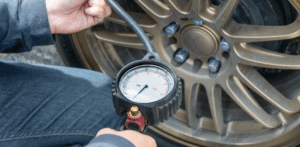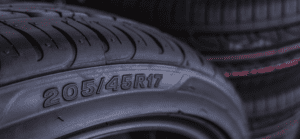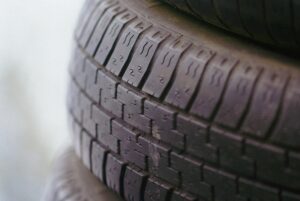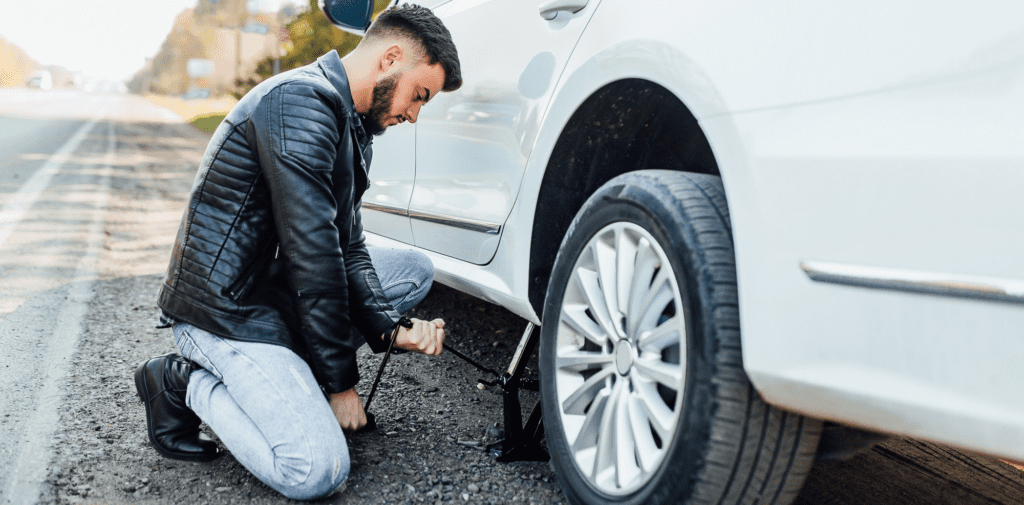
A flat tyre can ruin your day, but it doesn’t have to be a total disaster if you know what to do. This guide will walk you through the steps to take when you find yourself with a flat so you can get back on the road again quickly and safely.
- What to do when you get a flat tyre
- How to change a flat tyre
- How to avoid getting a flat tyre
- Frequently asked questions
We’ll cover how to assess the situation, including checking if it’s actually flat or just low on air. If it is flat, we’ll go over your options for either using a spare tyre, repairing the flat with a tyre plug kit, or calling for professional roadside assistance.
We’ll also discuss where to safely pull over, how to use your car jack to lift the car, how to remove the flat tyre, and properly put on the spare.
With the right preparation and knowledge, a flat tyre is just a minor hassle. We’ll make sure you have the information needed so if you ever find yourself with a flat, you’ll know exactly what to do.
Our goal is to give you the confidence and skills to handle this situation on your own so you can be back on the road in no time.
What to do when you get a flat tyre
Getting a flat tyre while driving can be a scary and frustrating experience. However, staying calm and knowing what steps to take will allow you to get back on the road again safely.
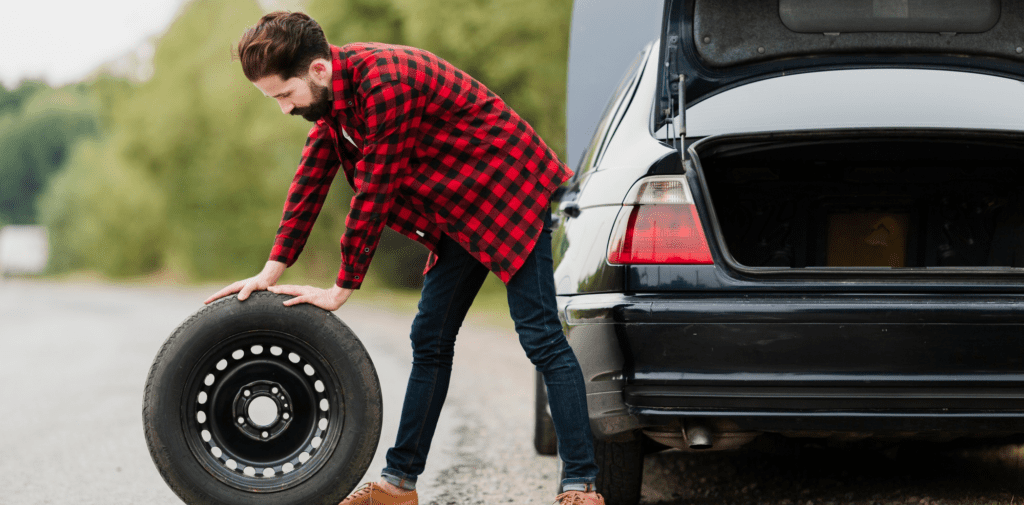
How to spot a flat tyre while driving
A flat tyre usually occurs gradually due to a small puncture that slowly leaks air. This can cause the car to pull to one side and make steering more difficult before you realise there’s an issue. Pay attention to any handling changes and visual signs like a visibly low or flat tyre.
Get to safety
Once you suspect a flat, signal and carefully pull over in the safest location possible. On a highway, use the shoulder. On smaller roads, find a wide spot where you won’t obstruct traffic. Do not continue driving long distances or at high speeds on a flat as this is extremely dangerous.
Listen to the experts
The Highway Code recommends only changing a tyre yourself if you can do so safely. Otherwise, call for professional breakdown service. Avoid changing a tyre on the highway shoulder or busy roads. Also do not attempt to change a tyre in the dark. If unsure, get help.
Check you have the right tools
Before changing a flat, confirm you have the proper equipment:
- Spare tyre
- Car jack
- Wheel chocks
- Wheel wrench and lug nut key
- Vehicle handbook for jack points
- Gloves
- Torch and reflective vest if at night
If missing critical items, call for professional assistance.
How to change a flat tyre
Changing a flat yourself requires careful preparation and following key steps.
Here is a comprehensive guide:
Stop and prepare your car
- Pull over in a safe, flat location and turn on hazards.
- Set the parking brake, put the car in gear, and turn off the engine.
- Have all passengers exit the car and move to safety.
- Put on a reflective vest if near traffic.
Keep the car from rolling
- Place wheel chocks diagonally across from the flat tyre. Use multiple chocks if available.
Raise the car
- Consult the owner’s manual to locate proper jack points.
- Position the jack under manufacturer-recommended lift points.
- Raise the car about 10 cm off the ground.
Loosen lug nuts
- Use a lug wrench to loosen nuts counter-clockwise.
- Loosen nuts completely but do not remove yet.
Remove and replace a flat tyre
- Lift flat tyre off wheel mounts.
- Install the spare tyre and hand-tighten lug nuts.
Lower the car and tighten the lug nuts
- Lower the jack until the tyre touches the ground.
- Use a wrench to fully tighten lug nuts in a star pattern.
Stow flat tyre and tools
- Place flat tyre, jack, and chocks away.
- Drive safely on a spare to get a standard tyre repaired.
Follow these steps precisely for a safe tyre change. Or call for assistance if needed. With preparation, you can handle a flat tyre change.
How to avoid getting a flat tyre
Inspect Your Tyres Regularly
The first line of defence against flat tyres is consistent and vigilant inspection. It’s recommended to visually inspect your tyres at least once a month.
By walking around the vehicle, closely inspect the tread and sidewall areas for any anomalies. Signs of wear, abrasions, cuts, or any embedded objects like nails, glass, or stones can be early indicators of potential trouble.
Should you discover a foreign object lodged within the tread, proceed with caution. For instance, while it might seem intuitive to immediately pull out a protruding nail, doing so might cause a sudden deflation, especially if the nail was acting as a temporary plug.
If you opt to remove such an object, listen carefully for any hissing sounds which may indicate air leakage.
Check the Pressure
Consistent visual checks are essential, but they don’t provide the whole story. Small punctures or slow leaks may not be immediately evident to the naked eye. Thus, monitoring your tyre’s air pressure is crucial.
For accurate readings, invest in a quality hand-held tyre pressure gauge. Refer to your vehicle’s owner manual to determine the recommended pressure for your tyres.
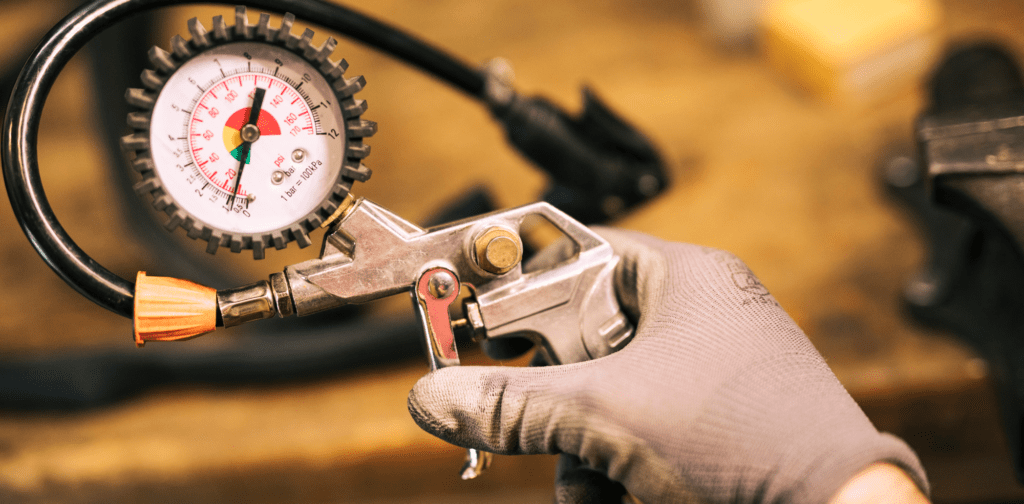
Checking the tyre pressure when they’re cold (having sat for at least three hours or driven less than a mile) will yield the most accurate results, as driving heats up the tyres, leading to inflated pressure readings.
Get a Second Opinion
There’s no shame in seeking expertise. If you’re uncertain about your tyre’s condition or its pressure, consult a professional. Many local garages offer free tyre inspections, and their trained eyes can spot issues that might escape the untrained observer.
Even if there’s a fee involved, the peace of mind and the prevention of potential accidents or inconveniences down the road are well worth it. Remember, proactive maintenance is always cheaper and safer than reactive repairs.
Frequently asked questions
The time it takes to change a flat tyre can vary based on your experience level:
- 15 minutes – If you are very experienced at changing tyres and have all the proper tools ready, you may be able to change a tire in 10-15 minutes. This would require being familiar with the jack points on your specific vehicle.
- 20-30 minutes – If you have changed a tyre before but still need to refer to the owner’s manual or instructions, it will likely take 20-30 minutes. Taking the time to carefully position the jack and loosen the lug nuts extends the process.
- 30-45 minutes – For someone who has never changed a tyre before, it often takes 30-45 minutes on the first try. You’ll need to move slowly, read instructions, identify tools, and get a feel for removing and replacing the tyre.
- Longer for larger vehicles – Larger trucks or SUVs with bigger, heavier tyres often take longer, especially if it’s your first time. Go slow and focus on safety.
The most important thing is to work methodically without rushing. Changing a tyre on the side of the road is not the time for shortcuts.
Focus on doing it properly for the best results. If uncertain, call for professional assistance. With some experience, you can change a tyre efficiently when needed.
Determining the proper tyre pressure for your vehicle is important. Here are the steps to find the PSI you need:
- Check your owner’s manual – The recommended tyre pressure for your specific make and model is listed in the owner’s manual. This is the first place to look.
- Look for a sticker – There will often be a tyre information sticker on the inside of the driver’s side door jamb. This lists the proper cold tyre pressure for both front and rear tyres.
- Check the tyres – The maximum pressure for the tyre itself is moulded into the sidewall. This is the maximum, not necessarily the recommended pressure.
- Ask the dealer – If you can’t find the information in the manual or on a sticker, call your vehicle’s dealer. Ask for the recommended tyre pressure for your tyres.
- Use a general guide – As a general rule, most passenger vehicle tyres perform well around 32-35 PSI. Refer to other sources for a more precise PSI.
Proper inflation is key for performance, fuel economy, and tyre wear. Check your pressure regularly with a tyre gauge to maintain the recommended PSI. Consistent inflation will help your tyres last longer and run more efficiently.
The minimum legal tread depth depends on the type of vehicle:
- For cars, light vans, and light trailers – The minimum legal tread depth is 1.6 mm across the central 3/4 of the tread around the entire circumference.
- For motorcycles, large vehicles, and passenger vehicles – The minimum legal tread depth is 1 mm across the central 3/4 of the tread.
- For heavy commercial vehicles – The minimum tread depth ranges from 1-1.6 mm depending on the type, per commercial vehicle regulations.
It is critical to regularly check your tyres to ensure they exceed the minimum legal limit. Tyres at the wear bar indicator or under the limit provide inadequate wet weather traction and should be replaced immediately.
You can measure tread depth easily using an inexpensive tread depth gauge found at auto parts stores. Insert the gauge into multiple points around each tyre to verify even wear and legal depth. Driving with excessively worn tyres can result in fines or dangerous handling issues. Know the regulations and replace tires proactively.
To ensure proper inflation and maximum tyre life, it is recommended to check your tyre pressure at least once a month. More frequent checks may be needed in certain situations:
- Check every 2 weeks if your vehicle is used for heavy loads or towing. The extra weight causes tyres to lose air faster.
- Check weekly during temperature swings. Tyre pressure fluctuates with outside temperatures.
- Check before long trips. Driving long distances at high speeds can affect pressure.
- Check after hitting potholes or curbs. Impacts like these can cause small punctures.
- Check when the tyre seems low. If you suspect a tyre is low, verify immediately.
- Check the spare tyre too. Spares can lose pressure over time.
The best practice is to give your tyres a quick visual inspection and pressure check whenever you fill up your gas tank.
This simple monthly habit will help you stay on top of tyre care and inflation. Proper pressure saves fuel, extends tire life, and prevents blowouts. Don’t ignore your tires – quick checks pay off in the long run.
Yes, there are serious consequences for operating a vehicle with unsafe, under-inflated, or excessively worn tyres. Driving with unroadworthy tyres puts yourself and others at great risk.
Potential penalties include:
- Fines up to £2,500 – You may receive a substantial fine of up to £2,500 for each faulty tyre. Fines increase if you own or operate commercial vehicles.
- 3 penalty points – Points on your driver’s licence for each unroadworthy tyre. This can lead to suspension if you accrue 12+ points.
- Disqualification from driving – You may be banned from driving for a period of time if convicted.
- Vehicle prohibition – Your vehicle could be prohibited from use until the faulty tyres are replaced.
- Invalidated insurance – Your insurer may void your policy if driving with known defects.
Routinely inspect your tyres and replace them proactively when worn. It is always safer and less expensive to address issues before an incident occurs. Never take risks with faulty tyres. Your safety and the law require tyres to meet legal standards at all times.
Winter tyres, sometimes called snow tyres, are tyres specifically engineered to provide enhanced performance in cold, snowy, and icy conditions. Here’s what makes them different:
- Tread compound – The rubber compound stays pliable below 7°C to maintain grip on ice and snow. It does not harden like all-season tyres.
- Deeper tread – The tread pattern is deeper, usually between 14-20mm, which improves snow traction and channels away slush.
- Siping – The tread blocks contain many small grooves or “sipes” that create extra biting edges to grab slippery surfaces.
- Lamella – Inside the sipes are reinforcing fibres called lamella that prevent the sipes from closing up and losing traction.
While all-season tyres work in light snow, winter tyres are mandatory for heavy snow regions. The soft rubber and aggressive tread prevent loss of control. For optimum winter safety and handling, install winter tyres on all four wheels.
While winter tyres are not legally required in the UK, they provide significant safety and performance benefits in cold, snowy conditions. Here are some factors to help you decide if you should switch to winter tires:
- Where you live – If you regularly drive in areas with frequent snow and ice, winter tires are highly recommended for safety.
- Types of roads – If you often drive on rural or mountain roads in the winter, winter tyres provide needed traction.
- Your comfort level – Switch if you feel uneasy driving on snow or ice with your current tyres.
- The vehicle you drive – Larger, heavier vehicles especially benefit from winter tyres’ improved snow grip.
- Your annual mileage – The more miles you drive each winter, the more use you’ll get from winter tyres.
While they involve some additional cost, winter tyres provide motorists in snowy climates with better acceleration, handling, and braking. This leads to more confidence and safety behind the wheel. Talk to a tyre shop about your driving needs to decide if switching to winter tyres is right for you.
The lifespan of tyres depends on several key factors:
- Tyre quality – Premium tyres can last up to 80,000 miles while cheap tyres last half as long. Higher quality means a longer lifespan.
- Tyre wear – Regular rotation and alignment extend tyre life by minimising uneven wear. Worn treads require replacement sooner.
- Climate and road conditions – Exposure to UV rays, ozone, and high heat degrades tires faster. Potholes and debris also cause wear.
- Driving habits – Speeding, rapid acceleration/braking, and overloaded vehicles reduce tyre longevity. Gentle driving preserves tyres.
- Maintenance – Lack of proper inflation pressure and alignment checks lead to premature wear. Proper upkeep maximises lifespan.
For most passenger vehicles driven conservatively, expect to get 40,000-50,000 miles out of a set of tyres under normal conditions. Heavily worn tyres should be replaced at 2/32” of tread depth regardless of age.
Regularly inspect your tyres to identify wear indicators requiring replacement. With proper care, quality tyres can safely last 5+ years.
There are several driving habits and vehicle issues that can accelerate tyre wear:
- Aggressive driving – Hard braking, fast starts/stops, and taking turns sharply breaks down tyres quicker.
- Overloading – Exceeding the vehicle’s weight capacity strains the tyres and increases wear.
- Underinflation – When tyres lack proper air pressure, more friction occurs with the road causing abnormal wear.
- Wheel misalignment – Improper alignment causes uneven treadwear and premature replacement.
- Imbalanced wheels – Wheels that are unbalanced create vibrations that damage tyres over time.
- Irregular rotation – Not rotating tyres leads to uneven wear of the treads and reduces lifespan.
- Worn suspensions – Shocks and struts that are worn out place more stress on tyres when driving.
- Climate and road conditions – Hot climates and poor roads with potholes also contribute to faster tire degradation.
The best way to maximise the life of your tyres is through regular maintenance and more conservative driving.
Check inflation frequently, rotate tyres, and get wheel alignments to avoid unnecessary wear issues. With care, you can add thousands of extra miles to your tyre’s lifespan.
Having a spare tyre in your vehicle is highly recommended for safety in the event of a flat. Here are reasons why a spare is important:
- Allows you to fix flat immediately – Spares let you get back on the road quickly instead of waiting for assistance.
- Provides a backup – Even brand-new tyres can get a nail puncture or blowout. The spare gives you a fallback option.
- Avoids being stranded – With no spare, a flat may leave you stranded in a dangerous place without access to help.
- Provides peace of mind – Knowing you have a spare tyre will give comfort and confidence if trouble arises.
- It’s required in some places – Some states require cars to have a spare as part of annual inspections.
Check that your spare is in good shape with proper pressure. Store the tools needed to change it. Rotate it into your regular tyre position occasionally to keep it functional. Taking the time to prepare allows you to rely on a spare when you need it most.
It is not recommended to continue driving any significant distance on a flat tyre. Here’s why:
- It’s extremely dangerous – A flat tyre makes controlling the vehicle very difficult and can cause sudden blowouts. This endangers your safety and others on the road.
- It causes further damage – Driving on a flat rapidly destroys the tyre and wheel components the longer you drive. It can damage beyond repair.
- No control over when it fails – A flat can fully fail at any moment, potentially at high speeds with catastrophic results. You have no control over when it gives out.
- Stranded without a spare – Driving the tyre to failure destroys it completely, leaving you stranded without a usable spare.
- Affects other components – Riding on a flat tyre can damage the wheel itself, suspension, steering, and alignment.
The only safe and recommended action is to pull over immediately and change to your spare or call for tyre service. Even driving 5 miles on a flat is extremely hazardous.
Never take the risk of driving on a compromised tyre. Your safety depends on properly inflated tyres in good condition.
The proper tyre pressures for front and rear tyres can vary depending on the vehicle. Here are some guidelines:
- For most passenger cars – Front and rear tyre pressures should be equal and matched to the PSI listed for your vehicle. Having them the same optimises handling.
- For trucks and SUVs – Rear tyre pressures are often higher (e.g. 35 PSI front, 50 PSI rear). This accounts for heavier loading in the back.
- For AWD/4WD vehicles – Tyre pressures should be equal all around to maintain proper operation of the drivetrain system.
- When towing – Rear pressures may need to be increased 10-15 PSI higher than fronts to level the load.
Always check your owner’s manual or tyre information sticker first to know the exact recommended pressures. Do not rely on the sidewall maximum as the proper pressure.
Unequal wear and impair handling if inflation pressures are unmatched side-to-side or front-to-rear. Know what PSI your vehicle needs for optimal tyre performance and safety.

